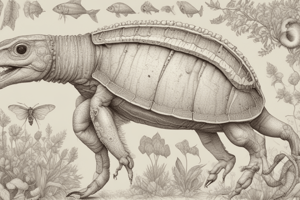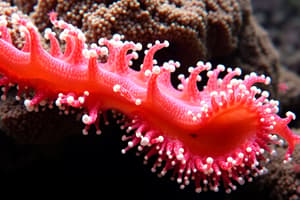Podcast
Questions and Answers
Which of the following characteristics accurately describes organisms in the Phylum Porifera?
Which of the following characteristics accurately describes organisms in the Phylum Porifera?
- Complex nervous system for coordinated movements.
- Ability to thrive in both marine and freshwater environments with no symmetry. (correct)
- Presence of well-defined tissues and organs.
- Exclusively marine habitat with radial symmetry.
How does water flow through a sponge, contributing to its filter-feeding mechanism?
How does water flow through a sponge, contributing to its filter-feeding mechanism?
- Water enters through pores, flows into the spongocoel, and exits through the osculum. (correct)
- Water enters through the osculum, passes through pores, and exits via the spongocoel.
- Water enters through the choanocytes, flows into the spongocoel, and exits through the pores.
- Water enters through the amoebocytes, passes through the osculum, and exits via the pores.
What is the structural organization of the body wall in Porifera (sponges)?
What is the structural organization of the body wall in Porifera (sponges)?
- Three-layer wall with epidermis, mesoderm, and endoderm.
- Single-layer wall composed of choanocytes.
- Two-layer wall with an outer epidermis and inner choanocytes. (correct)
- Multi-layered wall with specialized tissues and organs.
Cnidaria possesses radial symmetry and which of the following?
Cnidaria possesses radial symmetry and which of the following?
What is the role of mesoglea in Cnidarians?
What is the role of mesoglea in Cnidarians?
Which processes occur within the gastrovascular cavity of Cnidarians?
Which processes occur within the gastrovascular cavity of Cnidarians?
How do the polyp and medusa forms differ in Cnidarians concerning their lifestyle?
How do the polyp and medusa forms differ in Cnidarians concerning their lifestyle?
What is the function of choanocytes in sponges?
What is the function of choanocytes in sponges?
What are the primary functions associated with the mesoglea in cnidarians?
What are the primary functions associated with the mesoglea in cnidarians?
Which of the following is true regarding Cnidarian digestion?
Which of the following is true regarding Cnidarian digestion?
Flashcards
Phylum Porifera
Phylum Porifera
Pore bearer, parazoa. Mostly marine or freshwater, lacking symmetry.
Sponge water flow
Sponge water flow
Water flows in through pores, into the spongocoel, and exits via the osculum.
Cnidaria
Cnidaria
Animals with radial symmetry, 99% live in the ocean. Diploblastic with epidermis and gastrodermis layers.
Cnidaria Polyp form
Cnidaria Polyp form
Signup and view all the flashcards
Cnidaria Medusa form
Cnidaria Medusa form
Signup and view all the flashcards
Mesoglea
Mesoglea
Signup and view all the flashcards
Study Notes
- Invertebrates encompass every metazoan.
- The major invertebrate groups are:
- Porifera (5500 species)
- Cnidaria (10,000 species)
- Lophtrochozoa
- Ecdysozoa
- Deuterostomia
Phylum Porifera
- Translates to "pore bearer" and are parazoa.
- Characteristics:
- Primarily marine, but also found in freshwater.
- Lack symmetry.
Sponge Anatomy
- Sponges have no tissues.
- They possess a 2-layer wall composed of an outer epidermis and inner choanocytes.
- They use a liquid pump system where water flows through pores into the spongocoel, exiting through the osculum.
- Sponges are filter feeders, filtering water through choanocytes, nutrients move to amoebocytes.
Cnidaria
- Approximately 99% are found in the ocean.
- They exhibit radial symmetry.
- Cnidarians are diploblastic:
- Composed of epidermis and gastrodermis.
- Feature mesoglea between layers.
- They have tissues, but lack organs or organ systems.
- They reproduce through digestion.
- Cnidarians have a gastrovascular cavity where digestion occurs intra- and extracellularly.
- Gas exchange and waste discharge also take place in the gastrovascular cavity.
Cnidaria Forms
- Exists as Polyp and Medusa.
- Polyp form:
- Epidermis transitions through mesoglea to masoderm, leading to a cavity.
- Medusa form:
- Are free-floating in the water column
- They are solitary.
- Mesoglea functions as a nerve system, specifically a "nerve net"
- Senses touch, gravity, and light.
Studying That Suits You
Use AI to generate personalized quizzes and flashcards to suit your learning preferences.




